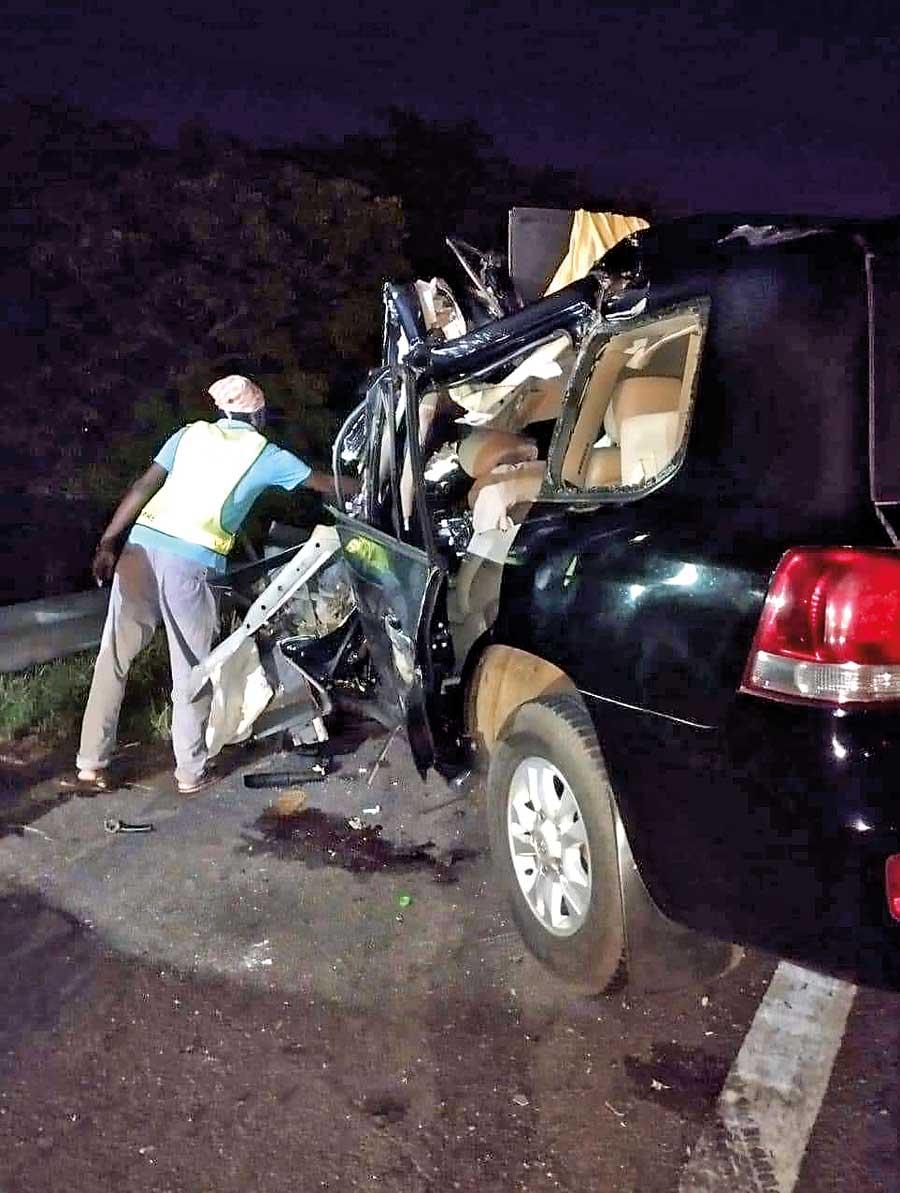26 Jan 2024 - {{hitsCtrl.values.hits}}

State Minister Sanath Nishantha and the police constable, who was his security officer, died in an accident on the Katunayake Expressway near Kandana in the early hours of January 25th. The jeep that was driving towards Colombo from Katunayake collided with a container vehicle that was driving in the same direction and then crashed into the safety fence.
Improving the management of road travel speeds will decrease traffic deaths and injuries in Asia and the Pacific. Policies focused on enforcement, road design, vehicle technology and urban planning are needed.
urban planning are needed.
Managing travel speeds on the roads of Asia and the Pacific will save lives and avoid economically costly, often debilitating injuries. Recent studies show that each 1% decrease in average speed will deliver a 4% decrease in crash deaths, and a 3.5% decrease in casualties.
This could help lower the staggering annual toll of 1.19 million lives lost due to road traffic accidents worldwide. In Asia and the Pacific, more than 2,000 people lose their lives in road crashes every day and many more sustain serious life-changing injuries, according to Asian Development Bank estimates.
Policies designed to lower road travel speeds are usually focused on education and enforcement. For sustained change, road design and features, and vehicle technology are important as well.
These are some of the most effective ways that policymakers can work to lower the road traffic speeds in their countries:
Enforcement and behaviour change. Enforcement can be effective if drivers believe that they will be caught for speeding, and believe that they cannot avoid the penalty. Three proven enhancements increase these beliefs and reduce speeding (driving at speeds above the speed limit).
Firstly, if the country is ready for them, the use of speed cameras – including mobile speed cameras – enhances the belief that the penalty cannot be avoided. The introduction of speed cameras should be prominently publicized to the community weeks in advance of their introduction.
Secondly, public education and campaign messages should focus on the risk of being caught for speeding and the significant penalties, and not merely on crash risk.
Thirdly, only a small ‘enforcement tolerance’ should be adopted, so that drivers are penalized for speeding at 3 km/h or 4 km/h above the limit, rather than setting the tolerance at 8 km/h or even 10 km/h above the limit. This change should also be strongly publicized weeks in advance of implementing it. Given that these changes might be unexpected for many, it is important to clearly communicate the supporting evidence and the psychological rationale behind these adjustments.
The use of speed cameras – including mobile speed cameras – enhances the belief that the penalty cannot be avoided. The introduction of speed cameras should be prominently publicized to the community weeks in advance of their introduction. Public education and campaign messages should focus on the risk of being caught for speeding and the significant penalties, and not merely on crash risk
Road Design and Speed-Managing Infrastructure
Many road design features are proven to manage speed, including speed humps or bumps, chicanes, raised platform crossings, lane narrowing, gateway treatments, and well-designed roundabouts. These are all shown to reduce speeds and reduce the numbers of serious crashes.
Lower speed limits are also needed, as reflected in global trends to best practice with urban speed limits being lowered in many countries from 50 km/h or 60 km/h to 40 km/h and now 30 km/h and even 20 km/h in areas with pedestrians. Asia-Pacific countries are making increasing use of 30 km/h speed limits, though much wider application is urgently needed.
Speed-managing infrastructure such as speed bumps, roundabouts or traffic circles are more powerful and sustainable than enforcement. Such traffic calming measures are more effective in reducing speeds than relying on drivers to believe that since they will be penalized they need to slow down. Traffic calming interventions work all day, every day and cannot be avoided or disputed by the driver, giving them a direct role without reliance on a compliant driver.
Vehicle Technology
Speed managing vehicle technology is becoming more common with the increasing availability of GPS (Global Positioning System) in vehicles which can let drivers know the speed limits at its current location.
This can take various forms: speed governing, which prevents a vehicle from exceeding a particular maximum speed; GPS-based speed limiting to the actual speed limit, and GPS-based warnings to the driver when exceeding the limit. Technologies that limit speeds, rather than just warn the driver, are the most powerful.
Reducing Speed through Modal Shift and City Planning
Speeds can also be reduced through sound city planning policies combined with offering and incentivizing shifts to transport modes other than personal vehicles. Opportunities include focusing on the development of commercial areas around public transport nodes, bus rapid transit systems replacing some lanes on multi-lane roads, and city planning which reduces the travel required to access services.
Lower speeds deliver multiple benefits including overall economic benefits. These can be achieved through road design and infrastructure, vehicle technologies, urban planning, modal shift, and effective deterrence.
Benefit to cost ratios for many speed reducing interventions show that they are excellent investments for governments. Given the benefits of lower speeds, including net economic benefits and the cost-effectiveness of many interventions, implementing stronger speed management is not a question of ‘Can we afford to do this?’ but ‘Can we afford not to do this?’
Ritu Mishra is a Transport Specialist attached to ADB Sectors Group. Joined ADB in 2018, she actively contributes to the strategic and operational support of transportation achieving the goals of climate finance. She is engaged in promoting sustainable transportation, transport infrastructure asset management, and road safety. She obtained her MSc. in Transport Planning and Engineering from the University of Leeds, and MSc. in Sustainable Development from the University of Sussex, UK.
Soames Job is a CEO and Principal of Global Road Safety Solutions Pty. Ltd, and he has over 40 years of experience in road safety, including successfully heading government lead organisations in road safety, providing road safety guidance to governments and leaders in over 100 countries and states, being a Professor in Road Safety, and consulted for many MDBs, the UN, the World Health Organization, ISO, and the OECD.
Courtesy
- Asian Development Blog
04 Jan 2025 3 hours ago
04 Jan 2025 3 hours ago
04 Jan 2025 4 hours ago
04 Jan 2025 4 hours ago
04 Jan 2025 5 hours ago